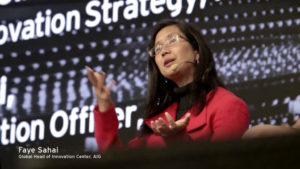CATEGORIES
Health and Wellness | Inclusion and Impact | Leadership and Networking | People We AdmireOverview:
- Faye Sahai shares how her childhood experiences shaped her commitment to diversity and inclusion.
- Key factors for scaling digital wellness technologies include intuitive design and a strong business model.
- The importance of networking and mentorship in personal and professional growth.
- Current trends in digital wellness emphasize personalized and predictive mental health solutions.
1. Can you tell us more about your childhood and how it shaped you into the person you are today?
My childhood was profoundly shaped by my parents’ immigration from Thailand to the United States and the many relocations that followed. I was often the only Asian child in my neighborhood and school, which exposed me to discrimination at an early age. For example, there were instances where my family’s driveway was vandalized with racist graffiti. These experiences were incredibly challenging, but they instilled in me a deep understanding of the importance of belonging and inclusion. I learned firsthand how critical it is to ensure that everyone feels valued and included. This understanding fueled my passion for advocating for diversity and inclusion in all areas of life and work, as I believe that varied perspectives create stronger communities and solutions.

2. How do you adapt your leadership style when working with diverse organizations, from startups to established global institutions?
My leadership style is situational and adapts based on the organization’s priorities, size, and culture. At AIG, when I led Global Innovation & Digital business, it was key to understand various divisions’ priorities and clients’ problems. It was also our priority to identify and test possible innovation solutions and technology disruptors. Our global rental car client was receiving 100+ data measures from each of their rental cars and wanted to ensure they leveraged the data to increase the safety of the drivers and reduce the wear and tear of their cars. We identified a solution, partnered with a company with a mobile app and algorithm, and created the Smoothest Drivers contest with prizes. The goal of the contest was to incent safe driving behaviors and discourage slamming on brakes and taking corners too sharply. It was a success in increasing driver safety and reducing wear and tear of rental cars and claims.
Conversely, with startups we invest in, it’s essential to understand the unique dynamics of the founding team, the maturity of the solution, and the competitive market and tailor my support accordingly, whether it’s strategic advice and support or facilitating introductions.
3. What core leadership philosophies have guided you?
My core leadership philosophy revolves around the growth mindset and the significance of active listening. We live in a dynamic and ever-changing environment, so being open to new ideas and learning continuously is essential. I practice an open-door policy, encouraging everyone in the organization—regardless of their position—to engage, ask questions, and share suggestions. Trust and relationships are paramount; fostering a diverse and inclusive team not only enhances innovation but also makes organizations more resilient and adaptable in times of change.
4. Based on your experience with innovation centers, what are the most important factors for turning new technologies into large-scale, impactful solutions in digital wellness?
My experience with venture investment and global innovation centers has taught me that several critical factors contribute to successfully scaling new technologies in digital wellness.
- First, having a strong business case for change is crucial. This means clearly articulating the value proposition and demonstrating quick benefits to stakeholders.
- Second, the solution and technology itself must be intuitive and user-friendly; if users find it difficult to navigate or require extensive training, adoption rates will be challenging.
- Third, integration into existing workflows is crucial—users need to see how the new solution fits seamlessly into their routines, processes, and technology.
- Finally, a sustainable business model is key. Who is paying for your service? What is the competitor landscape? What is your differentiation? Do you have a moat to defend your position/differentiation? Startups should consider strategic partnerships and their unique value propositions, ensuring they have the resources to support their innovations long-term.

5. How do you ensure that the startups you invest in maintain a commitment to inclusivity and impact?
To ensure that the startups I invest in uphold a commitment to inclusivity and impact, I take a multi-faceted approach:
1. We assess the team makeup; diversity within the team is critical for fostering innovative ideas and perspectives.
2. We look at the company’s values, policies, and culture to see how inclusivity is woven into their practices.
3. Additionally, I request data that showcases their commitment to diversity.
4. It’s also vital to understand their ecosystem, including strategic partners and vendors. Inclusivity should extend beyond the internal team to encompass all stakeholders.
By evaluating both qualitative and quantitative aspects, I can better ensure that the startups not only aim for sustainable competitive business but also maintain a strong focus on a positive culture that attracts and retains the best talent from a wide pool, avoiding the narrow group think.
6. How do you measure the success of an innovation project?
Measuring the success of an innovation project involves multiple metrics. To me, they are:
- Key traction metrics include the conversion rates of leads to adoption and customer retention over time.
- It’s essential to assess how effectively the project meets its objectives, particularly in healthcare settings—this involves evaluating health outcomes and the lasting impact of the solutions implemented.
- Additionally, business measures like cost-benefit analysis are crucial to understanding the overall value generated.
By considering these areas—traction, effectiveness, and business impact—I can gain a comprehensive view of an innovation project’s success.
7. What current trends in digital wellness and mental health excite you the most?
I’m particularly excited about the advancements in technologies that personalize and predict mental health solutions. Currently, it can take an average of ten years for individuals from the first inception of their mental health symptoms to find effective treatments. Emerging technologies that leverage AI, sensors, and even genetic information are helping to accelerate this process. These tools can more quickly assess the situation and create more tailored approaches to treatment, reducing the time it takes to find effective solutions. This personalization can significantly enhance the overall mental health journey for many individuals, making it more accessible and effective.

8. What are the biggest challenges women face in male-dominated fields, and what actionable steps can help foster more inclusive ecosystems?
Women in male-dominated fields often encounter challenges like implicit bias, lack of mentorship, and self-doubt. Many women may not apply for roles unless they meet nearly all the qualifications, while men may apply even if they meet only a fraction. To foster more inclusive ecosystems, it’s crucial to:
- Be inclusive in your practices, from recruiting to development to advancement.
- Create strong networks of support and find mentors and sponsors.
- Find your voice, own your career, and be your own advocate.
- Support one another.
9. If you could give advice to your younger self, what would it be?
If I could go back and advise my younger self, I would emphasize the importance of building relationships in the workplace. Early on, I believed that hard work alone would lead to success, so I focused on putting my head down, completing tasks, and doing my job. However, I’ve come to realize that career advancement is often more than doing the job and includes the connections you cultivate.
Building a network of colleagues, mentors, and sponsors can open doors and provide invaluable support. I would encourage my younger self to engage in conversations, share ideas, and actively seek out mentorship opportunities. By being more vocal about my aspirations, accomplishments, and networking effectively, I could have accelerated my career and created a more fulfilling professional journey.

10. What makes you happy? What are your hobbies outside of work?
- Outside of work, I find joy in traveling and experiencing new cultures.
- I also have a passion for chocolate—it’s a delightful treat that always brings a smile!
- Additionally, I love creating and building things, whether it’s art or products.
- Engaging in these hobbies provides a wonderful balance to my professional life and helps me recharge, especially as I look forward to traveling more now that COVID restrictions have eased.
11. What is something you’re grateful for in your personal or professional life?
I am deeply grateful for my family and the relationships I’ve built over the years. Recently, I faced the loss of my mother, which was incredibly difficult. Reflecting on her life, I realized that her accomplishments were important, but what mattered most were the connections she had forged with family and friends. This has reinforced for me the significance of relationships and support systems. At the end of the day, it’s the people around us who provide comfort and joy, making life truly meaningful.
Conclusion:
In conclusion, Faye Sahai’s journey highlights the profound impact of her childhood experiences on her commitment to diversity and inclusion. As a leader in digital wellness, she emphasizes the importance of intuitive design, a solid business model, and strong mentorship in scaling successful technologies. With a clear focus on personalized and predictive mental health solutions, Sahai’s insights shed light on the future of digital wellness—one where inclusivity and innovation drive meaningful change in mental health care.


